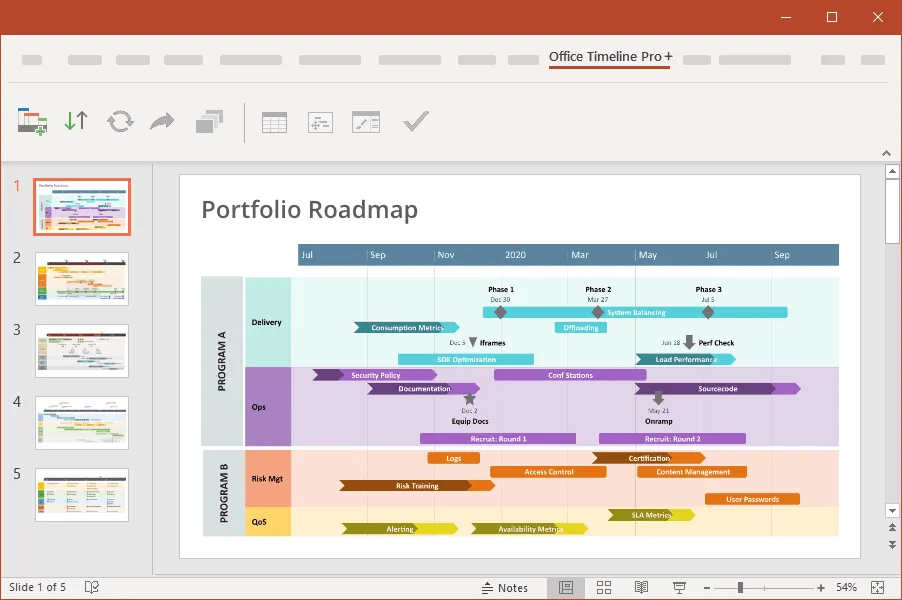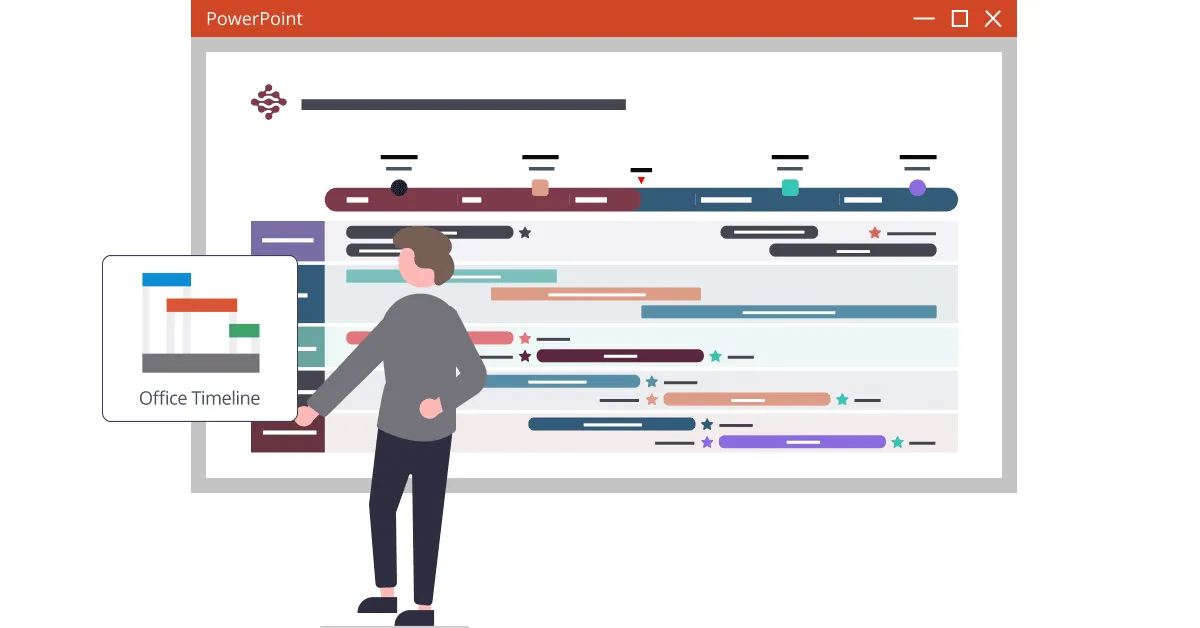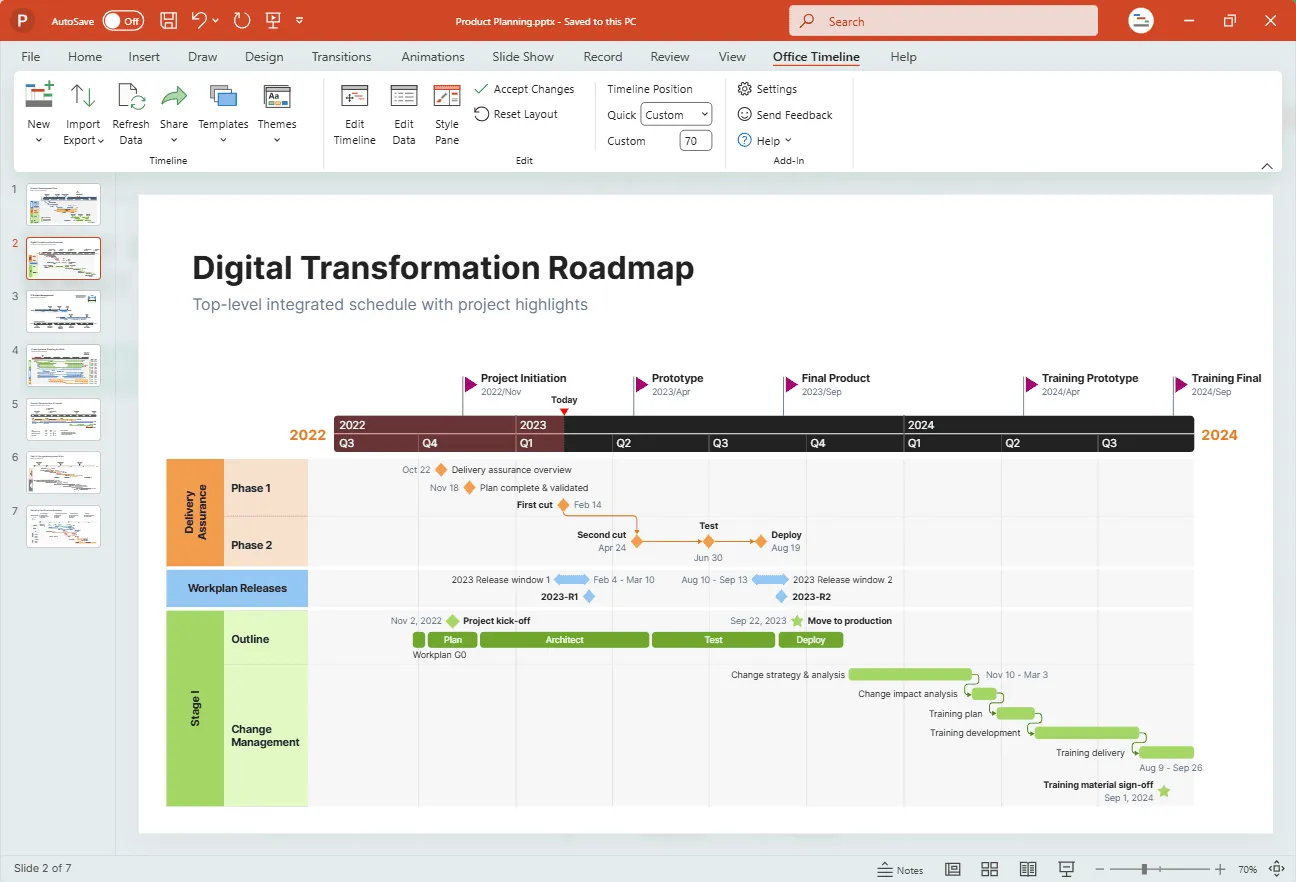Why it’s important to use a purpose-built roadmap maker
When it’s time to create a roadmap, many professionals fall back on makeshift solutions like spreadsheets, slide decks, or general project management tools. While these options can work in a pinch, they rarely deliver the clear, content-rich visuals a roadmap needs to engage stakeholders and communicate strategy effectively.
That’s where a dedicated roadmap maker comes in. Purpose-built roadmap software is designed specifically to help you visualize goals, milestones, and dependencies in a way that’s both professional and easy to update. Instead of struggling with tools that aren’t made for the job, you can save time, reduce errors, and produce visuals that make an immediate impact.
On this page, you’ll find resources that highlight the benefits of using specialized roadmap tools over generic software, along with best practices, feature breakdowns, and real-world examples to help you choose the right solution.
Keep reading to explore the advantages of roadmap creation tools, or skip ahead to the section that interests you most.
Benefits of a dedicated roadmap creator
Using an application built specifically for roadmaps offers clear advantages over generic tools:
Improve work speed and efficiency
Building a roadmap is a complex task, and using tools not designed for it – like spreadsheets or basic presentation platforms – can slow you down. They often require extra manual formatting just to get the data to display correctly. A dedicated roadmap maker simplifies this process with drag-and-drop functionality, ready-made templates, and professional themes. Updates are just as fast: instead of manually re-creating versions, you can adjust your visual on the fly and keep version control simple.
Present the right data to the right audience
Different stakeholders need different levels of detail. Executives may only want to see high-level initiatives and milestones, while delivery teams need specifics like features or dependencies. A roadmap creation tool lets you build multiple tailored views of the same plan – so every audience gets the right insights without you having to juggle separate documents. This flexibility makes meetings smoother and cross-referencing easier.
Enable more efficient sharing and collaboration
With a professional native roadmap app, your visuals can be exported in multiple formats or stored centrally with flexible access permissions. That means some users can view only, while others can edit directly. This ensures teams, clients, and leadership always stay aligned, no matter where they’re working. A roadmap tool purpose-built for collaboration keeps everyone connected and reduces miscommunication.
How to choose your purpose-built roadmap software
Selecting the right dedicated roadmap application is one of the first – and most important – steps in creating a strategic plan. Once chosen, this is the tool you’ll rely on throughout your project’s lifecycle. Pick the wrong software, and you risk hours of unnecessary rework, uninspiring visuals, and poorly tracked updates that leave stakeholders in the dark.
To ensure you find the roadmap tool that best suits your needs, here are four key factors to consider:
- Flexibility and easy updates
A roadmap is never static. Priorities, budgets, customers, and market conditions all change. Your roadmap software should let you quickly adjust plans so the visual always reflects current realities. - Accessibility and integration
Roadmaps must be available to everyone who needs them – whether that’s development, marketing, sales, or executive stakeholders. Look for a roadmap tool that makes sharing effortless and integrates smoothly with the other systems your teams already use. - Efficiency and ease of use
Building a roadmap should not add extra strain to project managers already focused on strategy, milestones, and stakeholder alignment. A time-saving roadmap maker with drag-and-drop functionality and pre-built templates helps you focus on strategy instead of formatting. - Clarity and visual impact
An effective roadmap is more than data on a page – it’s a persuasive visual that inspires confidence in customers, partners, and internal teams. Choose roadmap software that allows you to style and customize details into clear, distinctive visuals that stand out.
In short: choosing the right roadmap application means weighing the pros and cons carefully. The best option will be flexible, easy to use, visually compelling, and seamlessly connected to your existing workflows.
Roadmap maker for PowerPoint
Create professional roadmaps in PowerPoint with Office Timeline. Build, update, and share polished visuals in minutes – no design skills needed.

How to use a professional roadmap tool effectively
No matter which professional roadmap tool you choose, following a few best practices will help you structure your data and create roadmaps that are both clear and compelling. These guidelines ensure your roadmap communicates strategy at a glance while keeping stakeholders engaged:
Use color-coding for clarity
Assign different colors to categories, priorities, or task statuses. Color-coding makes your roadmap easier to scan, highlights what matters most, and helps your audience quickly see how initiatives connect within the bigger picture.
Show progress visually
Add progress bars or percentage indicators to signal how far along each task or initiative is. This not only builds transparency but also helps stakeholders track progress against goals.
Map out dependencies
Illustrate task dependencies with arrows, lines, or connectors. Visualizing relationships between activities prevents misunderstandings and makes bottlenecks easier to spot.
Differentiate activity types
Use simple visual cues to distinguish milestones, phases, and tasks. For example, diamonds are often used for milestones in product roadmaps, while they act as checkpoints in Gantt charts.
Keep it high-level
A roadmap should tell the strategic story of your project without overwhelming your audience with details. Focus on major phases and initiatives, grouping activities logically so the big picture remains clear and actionable.
Conclusion
Anyone involved in roadmap planning knows how critical it is to set the right direction from the very start of a project. A well-designed roadmap doesn’t just guide strategy – it creates alignment and confidence across the organization and beyond.
Here’s the impact a compelling roadmap can have:
- Customers can make informed purchasing and implementation decisions.
- Customer-facing teams (sales, support, marketing) gain clarity to build consistent documentation and training.
- Investors and sponsors can forecast revenues, costs, and resource needs more accurately.
- Product teams (designers and engineers) can focus on delivering higher-quality outputs.
- HR teams can better plan, adjust, and prioritize hiring activities.
- Legal teams can prepare contracts that support long-term growth.
Because roadmaps influence so many stakeholders, using the right tool is essential. Dedicated roadmap software makes it easier to create, update, and share visuals that are clear, professional, and always up to date.
Ready to choose the right tool for your business? Explore our guide to the 10 best roadmap software solutions based on user reviews for more insights.
FAQs about roadmap tools
Roadmap software can mean different things to different teams, so it’s natural to have questions before choosing the right tool. Below, we’ve answered some of the most common queries about roadmap makers – what they do, how to use them, and what to look for in the best solutions.
Roadmap software is a tool that automates the process of creating roadmaps, helping you plan upcoming work, balance workloads, set priorities, and track progress transparently. Key features typically include:
- Customizable roadmap templates;
- Milestone and task management (dependencies, status tracking, progress updates);
- Grouping items into categories or swimlanes;
- Flexible formatting and design options;
- Data import/export;
- Built-in sharing and collaboration.
The best roadmap software helps you plan faster, present clearly, and keep your visuals up to date. Top solutions share these characteristics:
- Time efficiency – automate roadmap creation and updates with just a few clicks.
- High customization – style your roadmap with flexible options for colors, shapes, fonts, and date formats.
- Ease of use – choose a user-friendly tool that produces visuals anyone can view, edit, download, or share.
- Integrations – connect seamlessly with project management tools like MS Project or Wrike to build roadmaps directly from existing data.
- Professional output – create polished visuals that strike the right balance between clarity and detail.
A roadmap example is a visual that illustrates the strategy and long-term plan behind an initiative, whether it’s launching a product, running a cross-functional project, or starting a new business. While formats differ, most roadmaps include:
- Goals and initiatives;
- Releases and milestones;
- Features;
- Dependencies.
To explore different formats, browse our collection of free roadmap examples and templates.
The simplest approach is to start with a roadmap template and customize it with your own data. For a more professional and flexible result, use a dedicated roadmap maker such as Office Timeline.
Whether you use a template or a purpose-built tool, here are the main steps to follow when you want to make a roadmap:
- Define project phases and timelines.
- Identify tasks, milestones, and dependencies.
- Group related work into swimlanes or categories.
- Keep the roadmap updated as priorities and progress evolve.


